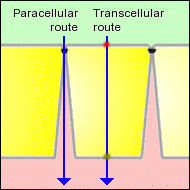VIVO Pathophysiology
Overview of Transport Across the Intestinal Epithelium
 There are two routes for transport of molecules and ions across the epithelium of the gut:
There are two routes for transport of molecules and ions across the epithelium of the gut:
- Across the plasma membrane of the epithelial cells (transcellular route)
- Across tight junctions between epithelial cells (paracellular route)
Some molecules, water for instance, are transported by both routes. In contrast, the tight junctions are impermeable to large organic molecules from the diet (e.g. amino acids and glucose). Those types of molecules are transported exclusively by the transcellular route, and only because the plasma membrane of the absorptive enterocytes is equipped with transporter molecules that facilitate entry into and out of the cells.
It is important to recognize that the epithelium of the gut is not a monotonous sheet of functionally identical cells. Additionally, tight junctions linking epithelial cells vary considerably in permiability along the gastrointestinal tract. As ingesta travels through the intestine, it is sequentially exposed to regions having epithelia with very different characteristics. This diversity in function results from differences in phenotype of the enterocytes - that is, the number and type of transporter molecules they express in their plasma membrane and the structure of the tight junctions they form. Even within a given segment there are major differences in the type of transport that occurs - for example, cells in the crypts transport very differently than cells on the tips of villi.
Within the intestine, there is a proximal to distal gradient in osmotic permiability. As you proceed down the tube, the effective pore size through the epithelium decreases. This means that the duodenum is much more "leaky" to water than the ileum and the ileum more leaky than the colon. Do not interpret this to mean that as you go down the tube, the ability to absorb water decreases! It means that water flows across the epithelium more "freely" in the proximal compared to distal gut because the effective pore size is larger. The distal intestine actually can absorb water better than the proximal gut.
The observed differences in permiability to water across the epithelium is due almost entirely to differences in conductivity across the paracellular path - the takehome message is that tight junctions vary considerably in "tightness" along the length of the gut.
Send comments to Richard.Bowen@colostate.edu

